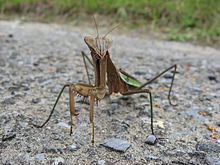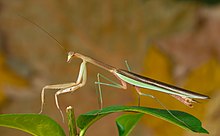Great chinese mantis
| Great chinese mantis | ||||||||||||
|---|---|---|---|---|---|---|---|---|---|---|---|---|

Great Chinese mantis ( Tenodera sinensis ), female |
||||||||||||
| Systematics | ||||||||||||
|
||||||||||||
| Scientific name | ||||||||||||
| Tenodera sinensis | ||||||||||||
| Saussure , 1871 |
The Chinese Mantis ( Tenodera sinensis ) is a Mantis from the family of Mantidae . It was originally native to East Asia and was introduced in parts of North America from the 19th century, mainly for the purpose of biological pest control . Due to the impact of the introduced species in these areas, this method is still controversial today.
features
Females reach a body length of approx. 100 to 130 millimeters, males one of approx. 70 to 100, which makes the Great Chinese Mantis a larger representative of the terrors. The front wings are colored brown, they show a green costal field. The hind wings are black-transparent. The legs and the muzzle are brown, as well as the abdomen, the pronotum and the head. However, there are also partially or solid green specimens. The color of the nymphs can vary between different shades of green and brown. The inside of the tentacles and the underside of the rear wings have eye patches that are held up to an attacker when threatening. Compared to other terrors of its size and family, the Great Chinese Mantis is a fast and agile runner, thanks to its long legs and narrow body, who can also jump accurately at short distances. As with many fishing horrors, the males, unlike the females, can also fly.
Similar species


A very similar species is the roughly equally large and closely related Japanese giant mantis ( Tenodera aridifolia ). In addition, other similar species can be found in the genus Tenodera . One example is Tenodera angustipennis , which however remains somewhat smaller than the other two species. Other similar species can be found in the tribe Polyspilotini and also in the subfamily Mantinae .
Occurrence
The Great Chinese Mantis was originally native to Asia ( Japan , China , Thailand, and Micronesia ), but was introduced to North America around 1895 and is widespread in the eastern United States . The fishing insect was also introduced in Australia . Other introduced species of the genus are the Japanese giant mantis and Tenodera angustipennis . The great Chinese mantid is also native to the extreme south of Ontario ( Canada ), on the shores of Lake Erie and Lake Ontario . At higher latitudes, the average temperatures are too low for the fishing insect to spread. The great Chinese mantis, one of the most widespread fishing horrors of all, inhabits a wide variety of habitats, such as pastures, forests, grasslands, the vicinity of water and also agricultural areas, which also favors the spread in the areas where the species was introduced .
Way of life

The great Chinese mantid inhabits higher grass, fields and bushes. There, like many terrors, it remains motionless for a long time and thus remains hidden by the camouflage. The rather aggressive Great Chinese Mantis defends itself like many terrors with a threatening gesture and if necessary with the thorned tentacles or bites.
The great Chinese mantis feeds mainly on other arthropods , but also on small vertebrates, such as smaller reptiles and amphibians , hummingbirds or mice , etc. In addition, the species has also been observed to overpower defensive animals such as the Asian giant hornet . There have also been sightings of specimens of the great Chinese mantid, which succeed in capturing both caterpillars and adult butterflies of the monarch butterfly without turning away from it. In order to bypass the toxins which the caterpillars absorb through plants and which are harmful to the fishing insects, the Great Chinese Mantis bites a hole in the stomach region of the caterpillar and lets the digestive tract fall out of this hole. This makes up about 40% of the entire caterpillar.
Reproduction
After 14 days of adult moult, both sexes are sexually mature. A female willing to mate attracts the male using pheromones, which the male can perceive up to a distance of 100 meters. The male carefully approaches the female, which signals readiness for mating by stretching out the tentacles. Occasionally the approach is also carried out frontally by the female. The male jumps or flies on its back after the signal has been given to the female. Pairing can take up to 16 hours. If the female is hungry during mating, it will begin to eat the male during mating. Because of this, males prefer nourished and also unfertilized females. Three weeks after mating, the first ootheca is deposited on dead, upright stems . Usually only one, but occasionally a further seven to nine ooths with 50 to 600 eggs as contents are added every two to three weeks. After two to three weeks, usually 200 to 400, on average 250 nymphs hatch. After hatching, the young are seven to eight millimeters in size and very light. The species is monovoltine , the females die after laying eggs. The animals overwinter in the egg, depending on the climate in the area of distribution. The young animals need eight moults before they reach adulthood. The life expectancy of the Great Chinese Mantid can be six to eight months.
Impact of the Great Chinese Mantis as a Neozoon


The great Chinese mantis was introduced primarily to control harmful insects, but the neozoon's impact on North American ecosystems is controversial as it does not distinguish between pests and other insects. In addition, it is feared that the species can cause great damage to the native fauna, as, due to its size, it has a comparatively large range of prey for fishing horrors. The great Chinese mantis is larger than any naturally occurring fishing insect in North America, which means that it is also seen as a potential threat to native species of fishing horror, such as Stagmomantis carolina . Furthermore, it is doubted that the Great Chinese Mantis is even suitable as a pest control for the animals to be controlled (such as cockroaches or gypsy moths ), as many of these animals rarely encounter the fishing insect due to their different ways of life, activity time and phenology. Other fishing horrors introduced for the purpose in North America are the European praying mantis ( Mantis religiosa ) and Tenodera angustipennis .
Taxonomy
The great Chinese mantis was originally regarded by Henri de Saussure as a subspecies of the Japanese giant mantis ( Tenodera aridifolia ) and described as Tenodera aridifolia sinensis . Today, however, it is viewed as a distinct species. It is counted within the subfamily Mantinae to the tribe Polyspilotini . The name Tenodera aridifolia sinensis , which is incorrect today , is still used frequently and there is a need to check the overlap zones with the sister species.
Terrariums
Due to its adaptability, the great Chinese mantid is not very demanding, which makes it one of the easier to keep fishing horrors. The Great Chinese Mantis is still comparatively little represented in German terraristics.
gallery
Detail of the head of a female with clearly visible ocelles
Detail of a male with pseudopupils
Male with predator cricket
Individual evidence
- ↑ a b c d e f g h i j k Description of the Great Chinese Mantis on PRAYING-MANTIS.org ( Link )
- ↑ a b c Housing report of the Great Chinese Mantis on www.froschportal.at ( Link ( Memento from March 11, 2012 in the web archive archive.today ))
- ↑ a b c d e f g h Claudia Heßler, Ingrid and Rudolf Bischoff: Mantiden - Fascinating Lauerjäger . 2nd corrected and enlarged edition. Edition Chimaira, Frankfurt am Main 2008, pp. 114–116.
- ^ A b c Gordon Gordh, David Headrick: A Dictionary of Entomology. Cab International, 2011, ISBN 978-1-84593-542-9 , p. 290.
- ↑ Reinhard Ehrmann: Mantodea: Gottesanbeterinnen der Welt. Natur und Tier Verlag, Münster 2002, p. 350.
- ^ A b Robert A. Cannings: Recent range expansion of the Praying Mantis, Mantis religiosa Linnaeus (Mantodea: Mantidae), in British Columbia. In: J. Entomol. Soc. Brit. Columbia. 104, 2007, p. 79. (online) (PDF; 508 kB)
- ↑ Brief description of the Great Chinese Mantis on macau biodiversity ( Link )
- ↑ a b Description of the Great Chinese Mantis on bugguide.net ( Link )
- ^ DA Nickle, J. Harper: Predation On A Mouse By The Chinese Mantid Tenodera aridifolia-Sinensis Saussure (Dictyoptera, Mantoidea). In: Proceedings of The Entomological Society of Washington. 83, 1981, pp. 801-802. (online) (PDF; 1.1 MB)
- ↑ Report on the feeding of monarch butterflies by the Great Chinese Mantis from the National Geographic website ( Link )
- ^ FR Prete, H. Wells, PH Wells, EL Hurd: The Praying Mantids. The Johns Hopkins University Press, Baltimore 1999, ISBN 0-8018-6174-8 .
- ↑ a b T. S. Bellows, TW Fisher: Handbook of Biological Control: Principles and Applications of Biological Control . Academic Press, 1999, ISBN 0-12-257305-6 , p. 392.
- ↑ a b Report on the impact of the Great Chinese Mantis on the North American ecosystem on the website of View from the Cape ( Link )
- ^ Henri de Saussure: Mélanges Orthoptériologiques - Mantides IV. 3rd volume, 21, H. Georg, Geneva 1871, pp. 363-462.
- ↑ Polyspilotini Tree of Life Web Project. Version dated November 22, 2005.
literature
- Reinhard Ehrmann: Mantodea: praying mantises of the world. Natur und Tier Verlag, Münster 2002, ISBN 3-931587-60-6 .
- Claudia Heßler, Ingrid and Rudolf Bischoff: Mantids - Fascinating watchers . 2nd corrected and enlarged edition. Edition Chimaira, Frankfurt am Main 2008, ISBN 978-3-930612-45-1 , pp. 114-116.
Web links
- Information about the Great Chinese Mantis ( Memento from March 11, 2012 in the web archive archive.today )


















